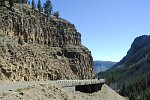Volcano Information
-
Yellowstone
- Current Update, last updated Nov 1, 2008 04:50 MDT:
OCTOBER 2008 Yellowstone Seismicity Summary
During the month of October 2008, 46 earthquakes were located in the Yellowstone region. The largest event was a magnitude 2.4 on October 5 at 3:12 PM MDT, located about 13 miles northeast of West Yellowstone, MT. No swarms were recorded during October.
Earthquake activity in the Yellowstone region is at relatively low background levels.
Ground Deformation Summary: Through October 2008, continuous GPS data show that much of the Yellowstone caldera continued moving upward, though at a lower rate than the past several years. The maximum measured ground uplift over the past 50 months is ~21 cm at the White Lake GPS station. An example can be found at: http://pboweb.unavco.org/shared/scripts/stations/?checkkey=WLWY&sec=timeseries_plots×eries=raw
The general uplift of the Yellowstone caldera is scientifically interesting and will continue to be monitored closely by YVO staff.
An article on the current uplift episode at Yellowstone and discussion of long-term ground deformation at Yellowstone and elsewhere can be found at: http://volcanoes.usgs.gov/yvo/2007/upsanddowns.html  Volcanic History Overview: The Yellowstone Plateau volcanic field developed through three volcanic cycles spanning two million years that included some of the world's largest known eruptions. Eruption of the >2450 cu km Huckleberry Ridge Tuff about 2.1 million years ago created the more than 75-km-long Island Park caldera. The second cycle concluded with the eruption of the Mesa Falls Tuff around 1.3 million years ago, forming the 16-km-wide Henrys Fork caldera at the western end of the first caldera. Activity subsequently shifted to the present Yellowstone Plateau and culminated 640,000 years ago with the eruption of the >1000 cu km Lava Creek Tuff and the formation of the present 45 x 85 km caldera. Resurgent doming subsequently occurred at both the NE and SW sides of the caldera and voluminous (1000 cu km) intracaldera rhyolitic lava flows were erupted between 150,000 and 70,000 years ago. No magmatic eruptions have occurred since the late Pleistocene, but large phreatic eruptions took place near Yellowstone Lake during the Holocene. Yellowstone is presently the site of one of the world's largest hydrothermal systems including Earth's largest concentration of geysers.
Volcanic History Overview: The Yellowstone Plateau volcanic field developed through three volcanic cycles spanning two million years that included some of the world's largest known eruptions. Eruption of the >2450 cu km Huckleberry Ridge Tuff about 2.1 million years ago created the more than 75-km-long Island Park caldera. The second cycle concluded with the eruption of the Mesa Falls Tuff around 1.3 million years ago, forming the 16-km-wide Henrys Fork caldera at the western end of the first caldera. Activity subsequently shifted to the present Yellowstone Plateau and culminated 640,000 years ago with the eruption of the >1000 cu km Lava Creek Tuff and the formation of the present 45 x 85 km caldera. Resurgent doming subsequently occurred at both the NE and SW sides of the caldera and voluminous (1000 cu km) intracaldera rhyolitic lava flows were erupted between 150,000 and 70,000 years ago. No magmatic eruptions have occurred since the late Pleistocene, but large phreatic eruptions took place near Yellowstone Lake during the Holocene. Yellowstone is presently the site of one of the world's largest hydrothermal systems including Earth's largest concentration of geysers. Location: Western US, WY
Location: Western US, WY
Latitude: 44.43
Longitude: -110.67
Elevation: 2805 m
Recent Eruption:- Hazard Assessments: Christiansen, R. L., Lowenstern, J. B., Smith, R. B., Heasler, H, Morgan, L. A., Nathenson, M., Mastin, L. G., Muffler, L. J. P., and Robinson, J. E., 2007, Preliminary Assessment of Volcanic and Hydrothermal Hazards in Yellowstone National Park and Vicinity, U.S. Geological Survey Open-File Report 2007-1071.
- Link to monitoring data:
Recent earthquake activity in Yellowstone National Park (map and catalog with links)
GPS Measured Horizontal Ground Motions
Provisional real-time stream-flow data
See the Yellowstone Volcano Observatory Monitoring Page for more.
Volcanic Alert Level: NORMAL Aviation Color Code: GREEN

